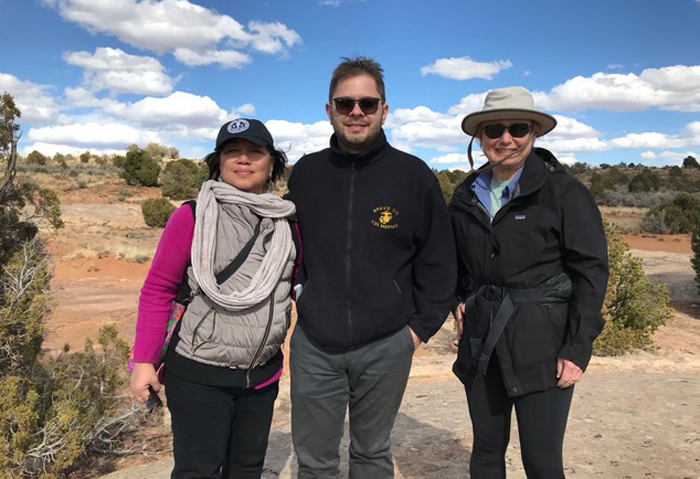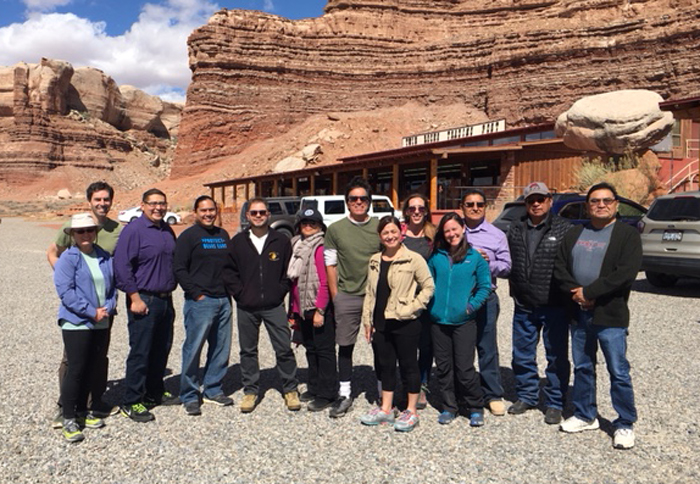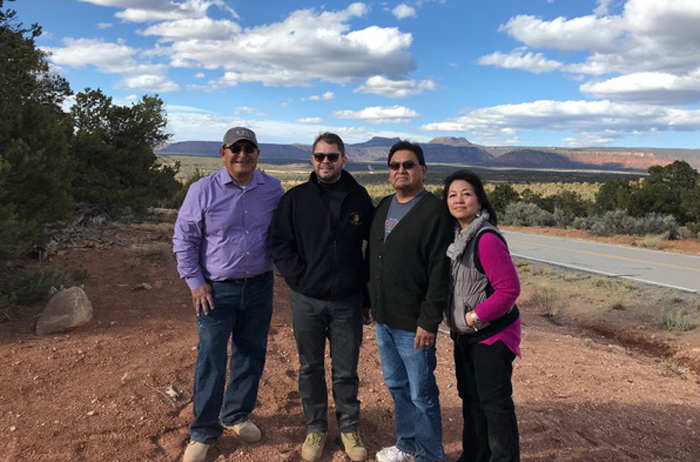
Sierra Club vice-president Susana Reyes, U.S. Rep Ruben Gallego (D-AZ), and Sierra Club Our Wild America volunteer co-lead Marion Klaus at Bears Ears National Monument.
When I visited Bears Ears National Monument last week, it was difficult to not be overwhelmed by the sheer immensity of the landscape. 1.35 million acres is one of those numbers that’s so big it’s difficult to grasp. (It’s a little bit bigger than the state of Delaware.) Because so many of those acres are at risk, I expected that to be one of the priority topics my trip guides would discuss. Donald Trump’s proclamation last December to reduce the size of Bears Ears ended up reducing the size of the national monument by over a million acres. Since one of the people in our group was U.S. Representative Ruben Gallego of Arizona -- the congressional sponsor of the Bears Ears Protection Act -- I figured there’d be a lot of chat about the legality of Trump’s decision and the technicalities that go along with federal land management. But that wasn’t the case -- nor, I soon learned, was the purpose of the Antiquities Act people’s main concern.
I’ll resist the temptation to launch into a history lesson, but the gist is that the ability of the Antiquities Act to designate national monuments for their cultural, historical, and ecological value is something special and unique.
It took only a couple of outings with Dine, Hopi, and Ute Nation youth to find out why. During two days of climbs, I heard the stories about the land’s importance to each of these nations -- whether it was the exact routes their ancestors trekked, the place they raised families, or tangible memorials of their family history, all right there and beautifully preserved. I learned about the hard work it took to break through barriers in forming a tribal coalition that would ultimately prove successful in getting their voices heard in Washington, D.C. The five tribes overcame their historical differences to come together into the Intertribal Coalition that worked on Bears Ears. That idea alone is enough to warrant serious concern about this strategic attempt to partition this landscape, undermine tribal unity, and later drill those lands at the expense of everyone who lives there.

Reyes (in cap, left of center) with Rep. Gallego and members of the Bears Ears Inter-Tribal Coalition -- the first time five nations stand tougher for Bears Ears: Hopi Tribe, Navajo Nation, Ute Mountain Ute Tribe, Pueblo of Zuni, and Ute Indian Tribe.
What I learned on those hikes, through the power of oral narrative, changed the way I view our country’s public lands. What I got were deep-history lessons about a people’s sense of place in the world, and creation stories that define what makes a place special and valuable and worth preserving. For Bears Ears, that value cannot be undervalued or overlooked nor lumped into the broader narrative of the Trump administration’s assault on our public lands. Every place has its own story and that’s the point.
All public lands were not created equal. Where national parks seek to get people outdoors and national forests allow conservation-driven use, some landscapes require a very different kind of protection. National monuments are designated as such for a reason; they encapsulate some sort of cultural, ecological, or historical value that’s unique and worth preserving. For Bears Ears, I now know, it is all three. The trip reminded me that national monument designations aren’t solely about how many acres are protected; nor are they centered on conservation-driven ideology -- they’re about the stories that live there. The designations are a tribute to the region, its history, and its people. If we lose these priceless pieces of our history, we will never get them back.

From left: Clark Tenakhongva, Vice Chairman, Hopi Tribe; Rep. Gallego; Davis Filfred, Navajo Nation Council Delegate; and Reyes at Bears Ears.
It’s easy to assign a dollars-and-cents value on oil extraction, but comparing these numbers to the value of living history on our country’s lands is like comparing apples to oranges. One of my role models, Terry Tempest Williams, says, “Story is a relationship between the teller and the listener, a responsibility. After the listening you become accountable for the sacred knowledge that has been shared.” Surely it’s easier to sound the alarm when places we know and visit -- places like Yosemite or Grand Canyon National Park -- are at risk. It is more difficult to put into words the places that are less familiar to the public. Bears Ears is more than a “place to enjoy” for those five tribal nations. It’s our responsibility to stand in solidarity with these people and protect their history. Their advocacy to preserve these landscapes, tell their stories, and work together, embodies the values entrenched in public lands advocacy. Now is the time to speak up and condemn in the strongest terms the travesty of carving up these national monument lands in order to search for dirty fuels that lie beneath the surface.